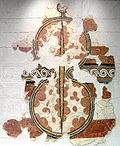Shield
A shield is a piece of personal armor carried by individuals, primarily soldiers or warriors, to deflect or intercept blows from weapons or projectiles like arrows. Historically, shields varied greatly in size, shape, and thickness; they could be made from wood, metal, leather, or other composite materials, depending on the period and region.
History[edit]
The use of shields can be traced back to the prehistoric times. The oldest form of shield was a protection device designed to block attacks rather than to attack an opponent. Shields have been used in countless cultures globally, with their design and construction depending on the specific needs and available materials of the culture that produced them.
Ancient Shields[edit]
In ancient civilizations such as those in Mesopotamia, Egypt, and Greece, shields were often large enough to cover the entire body and were constructed from wood and leather. The Greek hoplon, a heavy wooden shield, played a crucial role in the phalanx formation, a tight, interlocking shield wall that was effective in both defense and offense.
Medieval Shields[edit]
During the Middle Ages, shields evolved to suit the changing methods of warfare. Knights and foot soldiers used different types of shields, such as the kite shield and the buckler, which were smaller and more manageable in one-on-one combat. The development of armor technology eventually led to the decline in shield use, as full body armors provided sufficient protection.
Modern Use[edit]
Today, shields are primarily used by law enforcement and riot control forces. These modern shields are typically made from advanced materials such as reinforced plastics and are designed to protect against specific threats, including bullets and other projectiles.
Design and Function[edit]
The design of a shield has a significant impact on its functionality. Factors such as size, shape, and material affect the balance and protective capabilities of the shield. For example, round shields are easier to maneuver and are better suited for deflecting blows from multiple angles, while rectangular shields provide more coverage but can be cumbersome.
Cultural Significance[edit]
Shields also hold a rich cultural significance beyond their practical use in combat. They are often emblazoned with symbols, crests, or motifs that represent personal or familial identity, religious beliefs, or social status. In many cultures, shields are not only tools of war but also objects of art and ritual.
See Also[edit]
-
The uncivilized races of men
-
Mycènes bouclier
-
Mindanao Bangsamoro & Lumad Shields & Knives
-
Greek soldiers of Greco–Persian Wars
-
Archäologisches Landesmuseum Schloss Gottorf
-
Angkor Wat - Battle of Devas and Asuras
-
Sinjska alka - shield bearer and two squires
-
Police Officer with ballistic shield
-
U.S. Navy special warfare combatant-craft crewmen
-
Tempio di Hatshepsut
-
Warrior Alkimachos Painter
-
38-svaghi, lotta, Taccuino Sanitatis, Casanatense 4182
Ad. Transform your life with W8MD's Budget GLP-1 injections from $75


W8MD offers a medical weight loss program to lose weight in Philadelphia. Our physician-supervised medical weight loss provides:
- Weight loss injections in NYC (generic and brand names):
- Zepbound / Mounjaro, Wegovy / Ozempic, Saxenda
- Most insurances accepted or discounted self-pay rates. We will obtain insurance prior authorizations if needed.
- Generic GLP1 weight loss injections from $75 for the starting dose.
- Also offer prescription weight loss medications including Phentermine, Qsymia, Diethylpropion, Contrave etc.
NYC weight loss doctor appointmentsNYC weight loss doctor appointments
Start your NYC weight loss journey today at our NYC medical weight loss and Philadelphia medical weight loss clinics.
- Call 718-946-5500 to lose weight in NYC or for medical weight loss in Philadelphia 215-676-2334.
- Tags:NYC medical weight loss, Philadelphia lose weight Zepbound NYC, Budget GLP1 weight loss injections, Wegovy Philadelphia, Wegovy NYC, Philadelphia medical weight loss, Brookly weight loss and Wegovy NYC
|
WikiMD's Wellness Encyclopedia |
| Let Food Be Thy Medicine Medicine Thy Food - Hippocrates |
Medical Disclaimer: WikiMD is not a substitute for professional medical advice. The information on WikiMD is provided as an information resource only, may be incorrect, outdated or misleading, and is not to be used or relied on for any diagnostic or treatment purposes. Please consult your health care provider before making any healthcare decisions or for guidance about a specific medical condition. WikiMD expressly disclaims responsibility, and shall have no liability, for any damages, loss, injury, or liability whatsoever suffered as a result of your reliance on the information contained in this site. By visiting this site you agree to the foregoing terms and conditions, which may from time to time be changed or supplemented by WikiMD. If you do not agree to the foregoing terms and conditions, you should not enter or use this site. See full disclaimer.
Credits:Most images are courtesy of Wikimedia commons, and templates, categories Wikipedia, licensed under CC BY SA or similar.
Translate this page: - East Asian
中文,
日本,
한국어,
South Asian
हिन्दी,
தமிழ்,
తెలుగు,
Urdu,
ಕನ್ನಡ,
Southeast Asian
Indonesian,
Vietnamese,
Thai,
မြန်မာဘာသာ,
বাংলা
European
español,
Deutsch,
français,
Greek,
português do Brasil,
polski,
română,
русский,
Nederlands,
norsk,
svenska,
suomi,
Italian
Middle Eastern & African
عربى,
Turkish,
Persian,
Hebrew,
Afrikaans,
isiZulu,
Kiswahili,
Other
Bulgarian,
Hungarian,
Czech,
Swedish,
മലയാളം,
मराठी,
ਪੰਜਾਬੀ,
ગુજરાતી,
Portuguese,
Ukrainian












